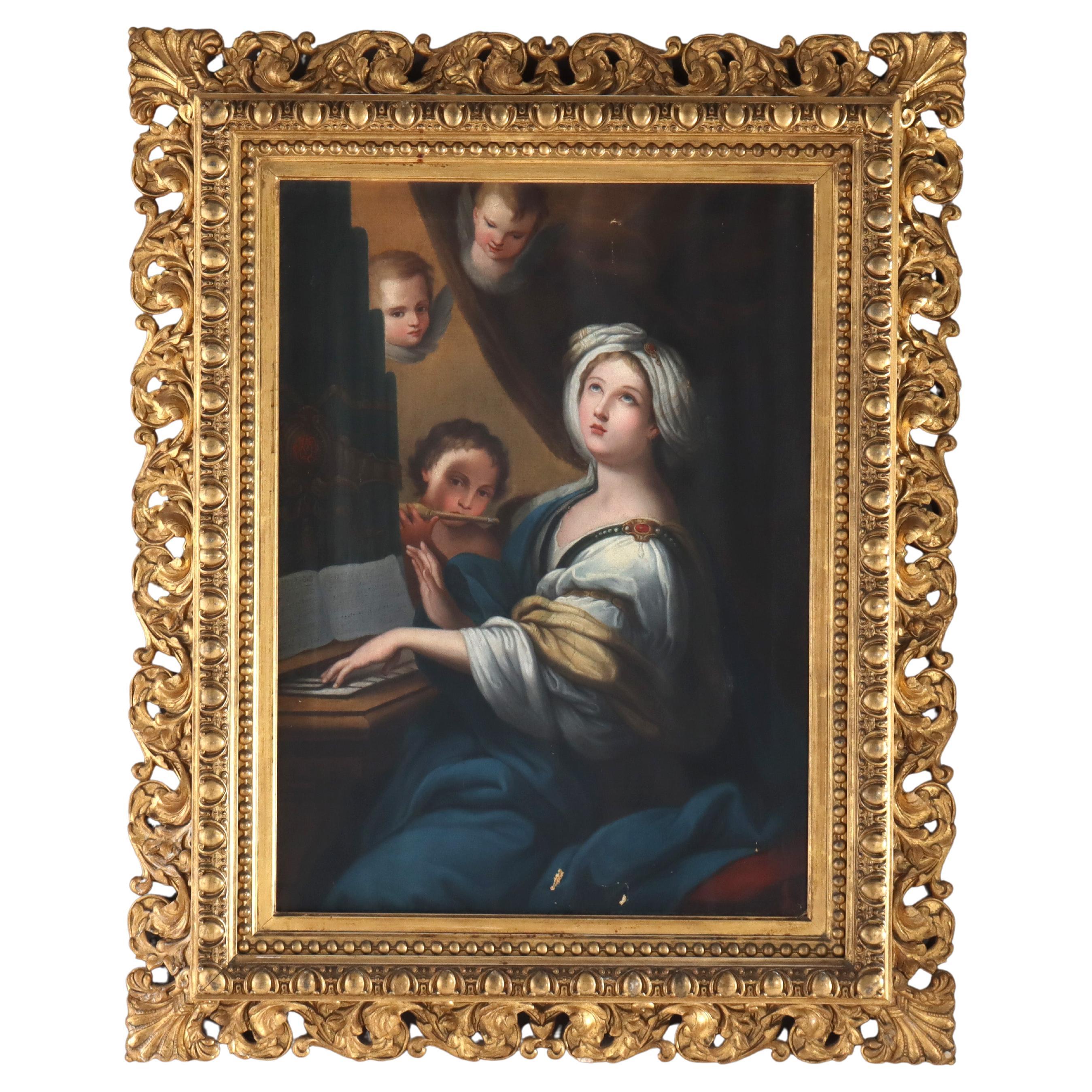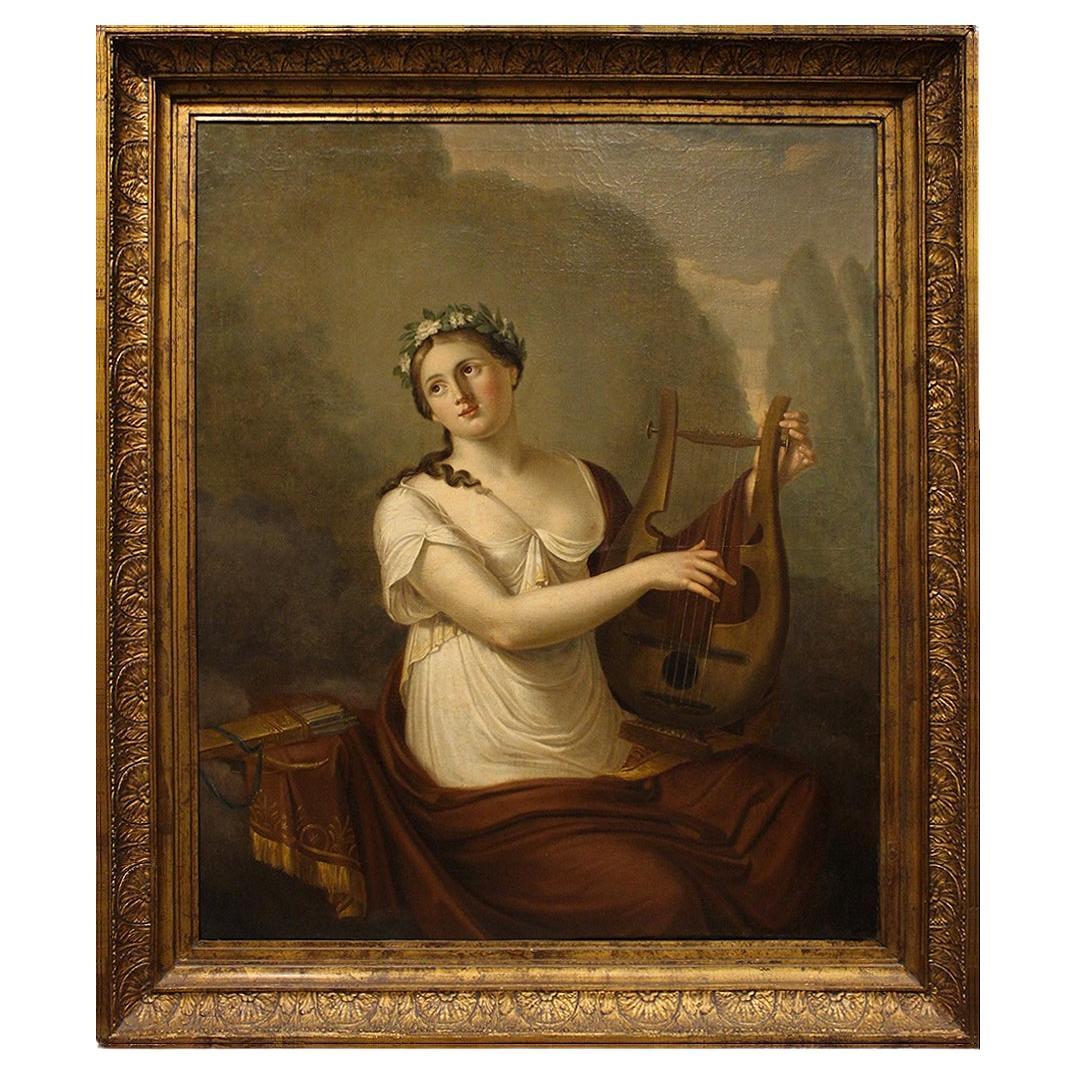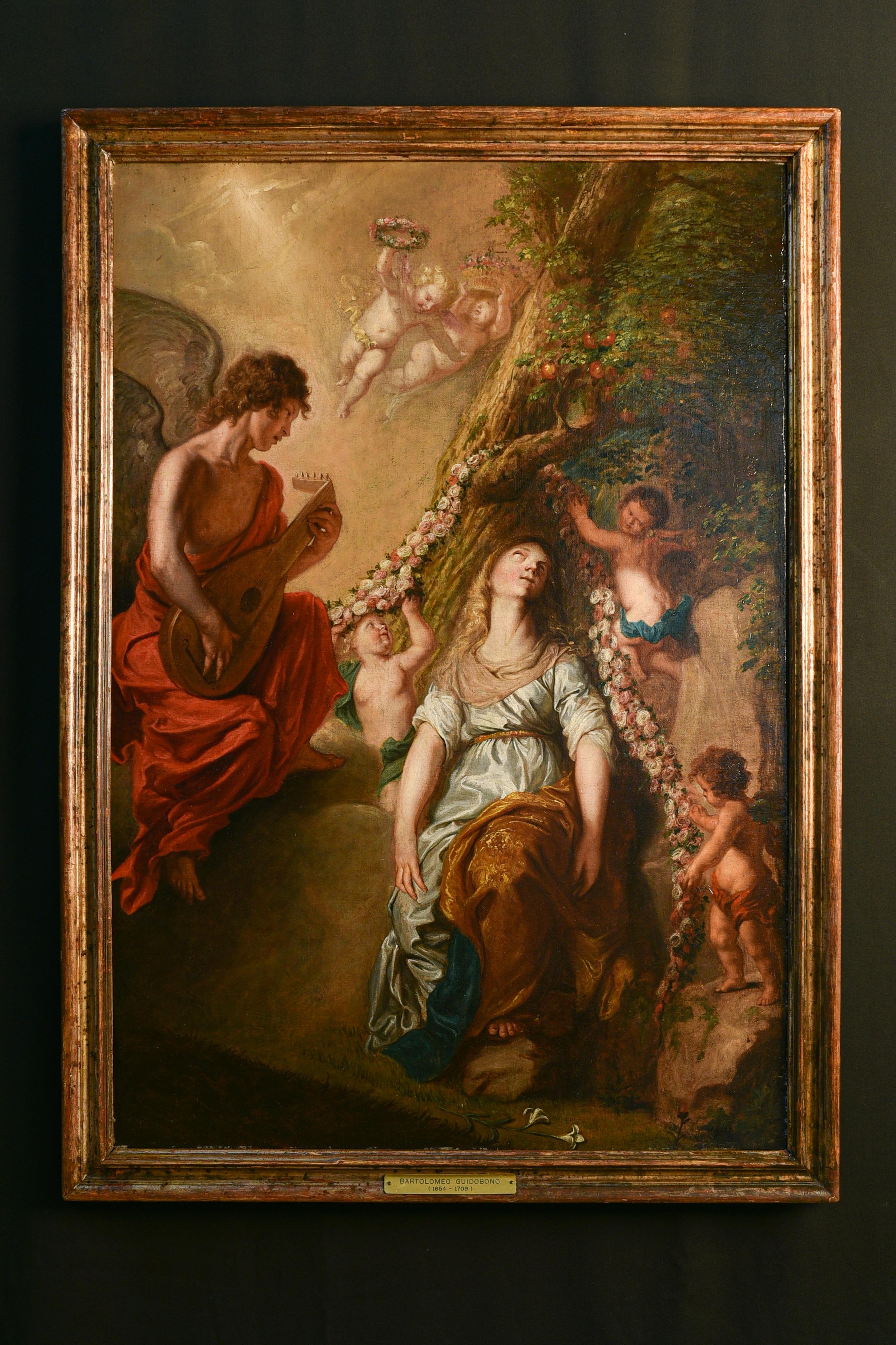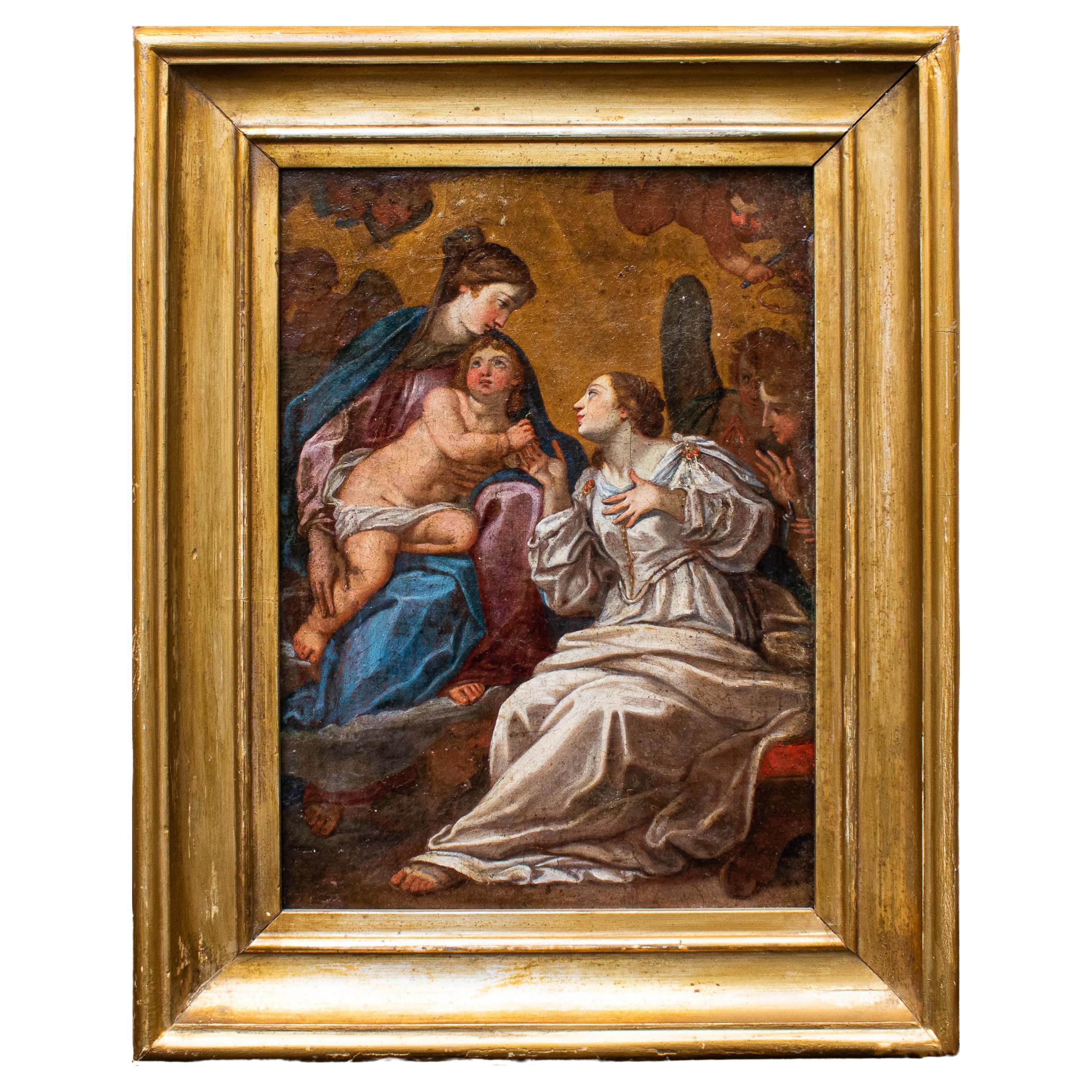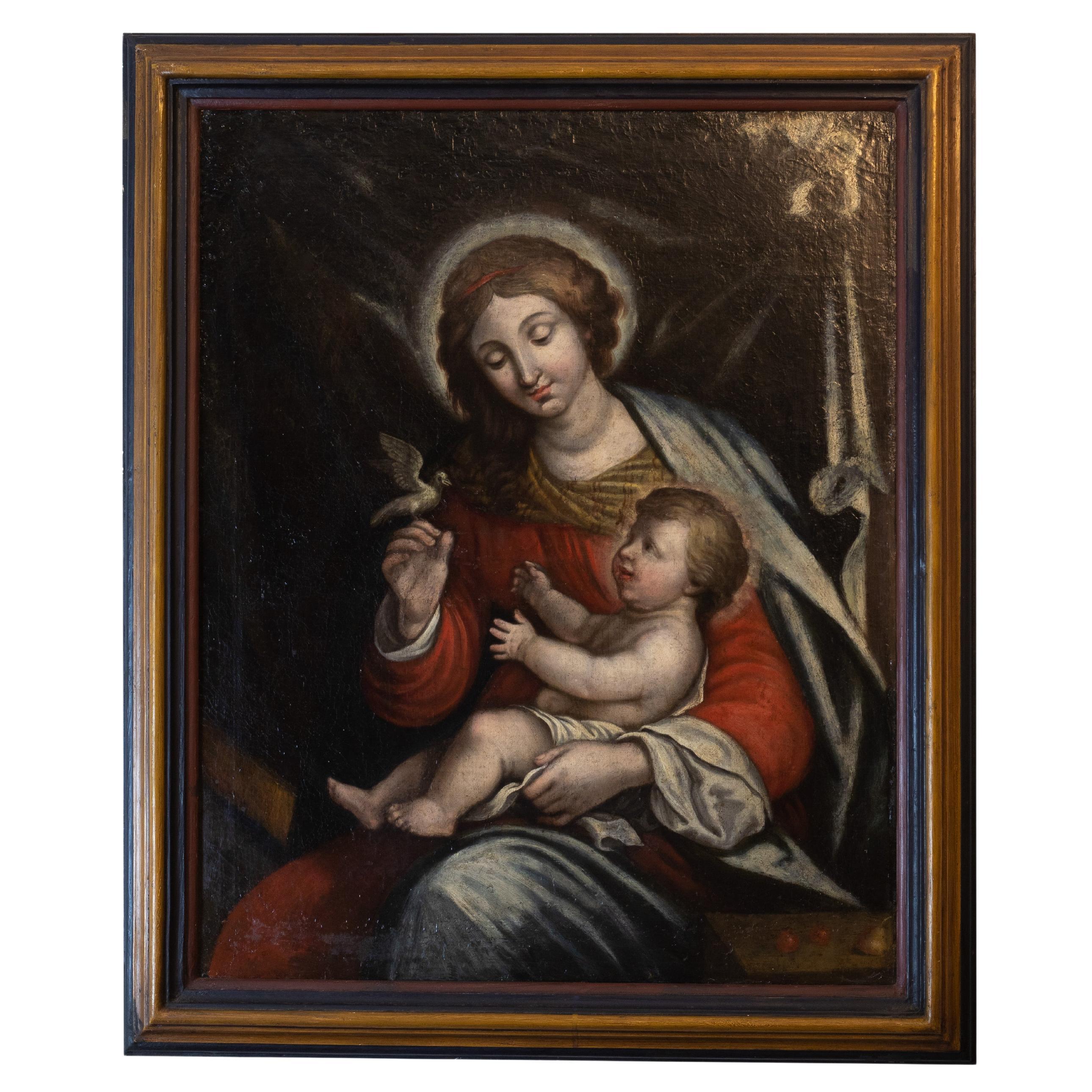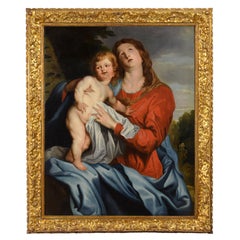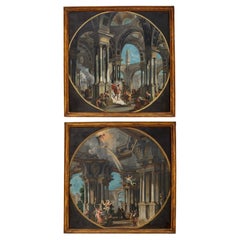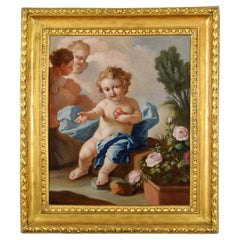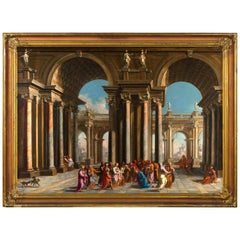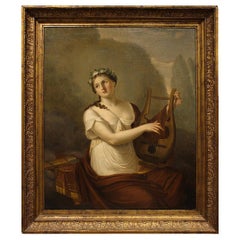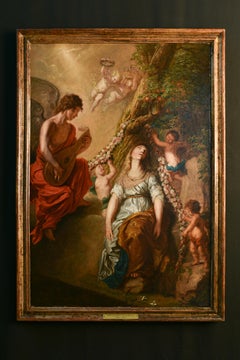Items Similar to 17th Century, Italian Painting with Saint Cecilia with Angels in Concert
Want more images or videos?
Request additional images or videos from the seller
1 of 9
17th Century, Italian Painting with Saint Cecilia with Angels in Concert
$37,806.48
£28,338.30
€32,000
CA$51,939.68
A$57,985.77
CHF 30,383.67
MX$709,802.72
NOK 385,872.92
SEK 363,829.17
DKK 243,595.67
About the Item
17th century Roman school, Santa Cecilia with angels in concert, oil painting on canvas
The valuable painting, in excellent condition, depicts Saint Cecilia playing the organ, surrounded by cherubs and cherubim. The saint, with an absent gaze and turned towards a mystical and divine light that transpires from behind the pipes of the organ and soft clouds, is dressed in refined and precious silk dresses. Next to her a putto hands her the musical score. The structure of the organ and the chair, in carved wood, reflect the stylistic dictates widespread in Rome in the Baroque era. The pavement in checkered, distorted prospectively, invites the observer’s gaze to converge towards the center of the canvas, where the face of the saint is represented. In the background, two imposing marble columns and a rich curtain frame the scene and serve as a fifth, increasing the compositional solemnity.
The author of the canvas is to be found in a painter active in Rome in the seventeenth century of skilled technical and compositional skills. The composition, played mainly in shades of brown, blue green and red, is harmonious and beautiful balanced. The natural rendering of silk fabrics, as well as of the skin tones, is proof of a high pictorial skill.
Iconographically, Saint Cecilia is often depicted playing an instrument and her image is often an allegory of Music itself, included in the Liberal Arts Quadrivium.
Cecilia was a Roman noblewoman, hence the sumptuous and rich clothing, lived between the second and third centuries. A.a. She was married to Valerian, also a descendant of a noble Roman family. On the night of the wedding, Cecilia revealed to her husband her conversion to Christianity and her decision to take a vow of chastity. The husband accepted his wife’s wish, converted himself to Christianity and had his brother Tiburzio converted as well.
All three thus began a work of spreading the new religion and Cecilia, excellent speaker, soon managed to convert many Romans, protected and helped by the two brothers soldiers. For their charitable activities, their fame grew so fast that they were condemned to martyrdom by the Roman prefect Turcio Almachio. Saint Cecilia is known to be the patron saint of music. His approach to this art was generated by an incorrect interpretation of the texts of the antiphonaries that were used in the masses during the celebrations for the saint.
The original text reads as follows: "Candentibus organis, Caecilia virgo in corde suo soli Domino decantabat.", that is "Among the organs (instruments of martyrdom) glowing, the virgin Cecilia sang praises to God in her heart". The wrong interpretation is in the first sentence, transcribed as follows, "Cantantibus organis" or "Among the organs(musical instruments) playing", therefore listening to heavenly music sang praises to God in his heart.
Thus begins, from the fifteenth century, the iconographic fortune of Cecilia, to whom were attributed musical abilities. Thus, the saint was given a portative organ as a symbol of her excellent skills as a musician and since then she has been invoked by singers and composers as their protector.
Art history studies are currently underway.
- Dimensions:Height: 49.61 in (126 cm)Width: 40.56 in (103 cm)Depth: 3.15 in (8 cm)
- Style:Baroque (Of the Period)
- Materials and Techniques:
- Place of Origin:
- Period:
- Date of Manufacture:17th Century
- Condition:Refinished. Wear consistent with age and use.
- Seller Location:IT
- Reference Number:1stDibs: LU4405232769182
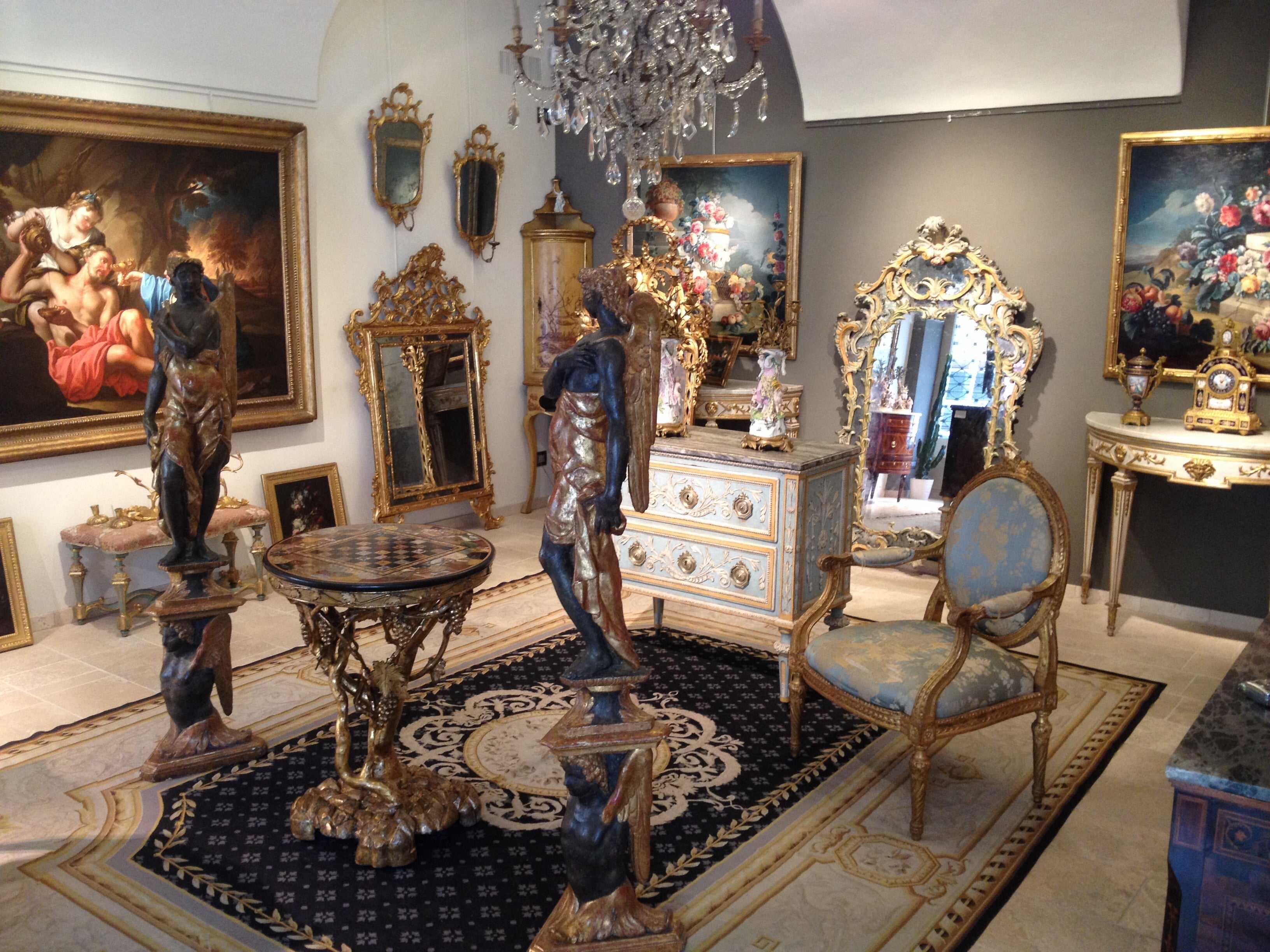
About the Seller
5.0
Platinum Seller
Premium sellers with a 4.7+ rating and 24-hour response times
Established in 1980
1stDibs seller since 2019
56 sales on 1stDibs
Typical response time: 1 hour
- ShippingRetrieving quote...Shipping from: Italy
- Return Policy
Authenticity Guarantee
In the unlikely event there’s an issue with an item’s authenticity, contact us within 1 year for a full refund. DetailsMoney-Back Guarantee
If your item is not as described, is damaged in transit, or does not arrive, contact us within 7 days for a full refund. Details24-Hour Cancellation
You have a 24-hour grace period in which to reconsider your purchase, with no questions asked.Vetted Professional Sellers
Our world-class sellers must adhere to strict standards for service and quality, maintaining the integrity of our listings.Price-Match Guarantee
If you find that a seller listed the same item for a lower price elsewhere, we’ll match it.Trusted Global Delivery
Our best-in-class carrier network provides specialized shipping options worldwide, including custom delivery.More From This Seller
View All17th Century, Italian Painting with Virgin and Child by Follower of Van Dyck
By Anthony van Dyck
Located in IT
17th century, Italian painting with virgin and childr by Follower of Sir Anthony van Dyck
cm W 90 x H 113; cornice cm W 111 x H 135 x D 7
The canvas depicts the Madonna with the Chi...
Category
Antique Late 17th Century Italian Baroque Paintings
Materials
Canvas
18th century, Couple of Italian Paintings Capriccio with Mythological Scenes
Located in IT
Couple of architectural capriccio with mythological scenes, oil on canvas, painter from Bologna active in the 18th century
The two large and valuable pantings depict two architectur...
Category
Antique Early 18th Century Italian Baroque Paintings
Materials
Canvas
18th Century, Italian painting with Sacred Heart of the Child Jesus by Pietro Ba
By Pietro Bardellino
Located in IT
Pietro Bardellino (Italy - Naples, 1732 - 1806), attr., Sacred Heart of the Child Jesus
Measurements: with frame, cm L 86 x H 99 x P 8; only the canvas, cm L 78 x H 64
The painting, made in oil on canvas, represents the Sacred Heart of the Child Jesus. Stylistically the work is attributable to Pietro Bardellino (Italy, Naples, 1732 - Naples, 1806), a pupil of Francesco De Mura and considered by critics one of the most gifted and sensitive exponents of the Rococo style in Naples.
The canvas represents the Child Jesus, surrounded by flowers in an outdoor setting, while showing the sacred heart. The canvas has a well-balanced color and a strong sweetness of the child’s traits, which with the complicit gesture of the right hand, involves the viewer in the intimate and delicate sharing of the garden in which he sits. The roses, in addition to being a beautiful piece of still life, contribute to enrich the Christological message, being bearers of symbolic meanings. Marian attributes par excellence, are often side by side with Christ, whose thorns foreshadow the Passion. In the canvas, on the top left, two cherubim are observed: among them, according to the Old Testament, is God: the author therefore puts into place an iconographic and iconological hyperbole that amplifies its meaning. The iconographic theme of the Child Jesus with the Sacred Heart in his hand spread between the second half of the eighteenth century and the first of the following century. With the worship of the Sacred Heart of Jesus, the Catholic Church intends to honour the Heart of Jesus Christ, one of the organs symbolizing his humanity, which by intimate union with the Divinity, has the right to worship and love of the Saviour for men, of which His Heart is the symbol. It represents one of the fundamental devotions of Christian life, as it manifests the true face of God, who is prodigal and boundless love. It was the French mystic Saint Margaret Mary Alacoque...
Category
Antique Mid-18th Century Italian Baroque Paintings
Materials
Canvas
Alberto Carlieri, Capriccio with Christ and the Adulteress, Oil on Canvas
By Alberto Carlieri
Located in IT
Alberto Carlieri (Italy-Roma 1672-1720), "Christ and the adulteress",
Oil on canvas, with frame cm H 115 x L 151 x 6.5, only canvas H 98.5 x L 135 cm...
Category
Antique Late 17th Century Italian Baroque Paintings
Materials
Canvas
18th Cent., Italian Painting, Loth and the daughters, att. to Giuseppe Gambarini
By Giuseppe Gambarini
Located in IT
Giuseppe Gambarini (Bologna, 17 March 1680 - Casalecchio di Reno, 11 September 1725)
Loth and the daughters
Oil on canvas; Measurements: cm H 73 x W 93; frame H 88 x W 108 x D 5,5
The painting, of beautiful pictorial quality, depicts the biblical scene of Lot and his daughters, with Sodom set on fire in the background, and is stylistically attributable to the italian painter Giuseppe Gambarini (Italy, Bologna, 17 March 1680 - Casalecchio di Reno, 11 September 1725).
The canvas shows in the center Lot sitting and already drunk, depicted according to traditional iconography, old, gray and with long gray boat. With his left hand he grabs the wine flask that one of his daughters offers him. She is depicted kneeling and resting on large boulders of stone, described as an architectural base, dressed in a voluminous deep blue mantle, her hair covered with a humble headdress made of a knotted cloth; look at the viewer, as if to want to involve him directly in the scene. The other daughter is described on the left, from the back to the observer, with a bare back and dark hair gathered by a red ribbon. She too is intent on serving her father a cup in which to pour the wine. Around them a duck placed on a cloth, some bread and another wine flask enrich the composition describing a banquet in progress. The scene is set outdoors, where only a large tent supported by branches arranged in a hut serves as a shelter to the figures. In the background a forest landscape blends chromatically with the blue sky. To the right in the distance, is described the city of Sodom, already destroyed and on fire. Lot’s wife...
Category
Antique Early 18th Century Italian Baroque Paintings
Materials
Canvas
$21,738 Sale Price
20% Off
17th Century, Italian Painting by Pier Francesco Cittadini, Jacob and his Family
Located in IT
Pier Francesco Cittadini (Milan, 1616-Bologna, 1681)
"Jacob and his family go to Egypt"
Oil on canvas, cm 109 x 190 (canvas only)
The valuable painting, made in oil on canvas, depicts Jacob and his family go to Egypt and we believe it can be, given the high quality painting, autograph work of Italian Pier Francesco Cittadini (Italy Milan, 1616 - Bologna, 1681) made after 1647. The work, in excellent condition is accompanied by a coeval frame in wood finely carved and golden.
The scene depicted, which was confused with the Flight to Egypt in the past years, is instead identified with the biblical episode of Jacob’s journey. In the foreground, reading the painting from left to right, we see a caravan composed of animals, including donkeys, dromedaries, goats, dogs and horses and people, women, men and slaves, who carry on their journey along the banks of a river, following a path that to the right, would seem to lead to the through of a bridge. In addition to the watercourse is described an environment characterized by large rocks and impervious come far to cover the entire verticality of the canvas. On the left, in the distance, we see the tail of the caravan that runs along the steep path. Large trees enliven and harmonize the environment, as well as white and grey clouds characterize the predominantly clear sky and illuminated on the right by sunlight.
The story is told in the Bible, Book of Genesis, 30, 25, passage in which is described the flight of Jacob from Haran after the contrasts with Laban, father of his wife Rachel. Jacob is the third great patriarch of the Bible. From his descendants originate the twelve generations of the people of Israel. He is the son of Isaac and Rebekah, who led him to flee from the wrath of Esau to Haran to seek refuge from his brother, Laban. At his uncle’s house Jacob met his daughter Rachel. As soon as he saw his cousin, Jacob was taken. Jacob will stay seven years in the service of Laban to marry his beloved Rachel. But Laban, with a deception, will give him in marriage first Lia, the least beautiful eldest daughter, and only after another seven years the splendid Rachel. From his first wife he will have several children, while Rachel will give birth to the beloved son, Joseph, who will become viceroy of Egypt.
After years of service, Jacob asked to be paid with every dark-coloured garment among the sheep and every spotted and dotted garment among the goats. Laban accepted and sent away from his sons all the leaders of that kind. So Jacob took fresh branches of poplar, almond and plane tree, and flayed them, and put them in the troughs. The optical suggestion induced the goats and the sheep to conceive and give birth to dark, striped and dotted garments. He also ensured that all the strongest and healthiest leaders of the flock of Laban would drink near the barked branches, thus assuring a genetic superiority to his part of the flock. His flocks grew numerous and strong and he became richer than his relative, arousing envy. It was clear that Laban would not respect him much longer. At the suggestion of the Lord, Jacob decided to return to Canaan. Trying to avoid any possible dispute, he left with his family while Laban was absent for shearing sheep. But when, three days later, his uncle returned home, he became angry, feeling offended because Jacob had gone secretly and had not allowed him to greet his daughters and grandchildren. In addition, his teraphim, statuettes, or idols, which depicted the family deities, had disappeared. After 7 days of pursuit, Laban and his men reached Jacob’s group on Mount Gilead, in the mountainous region west of the Euphrates River, where his uncle and grandson had a stormy conversation. The younger man was outraged at being accused of stealing idols and told Labano to rummage through his family’s tents at will. Neither of them could know or even imagine that it was Rachel who took the idols and hid them in the saddle of the camel. During the search, she sat down firmly on the saddle, apologizing for not being able to get up, «because I usually have what happens to women» (Gen 31:35). So the loot wasn’t discovered.
The author of this work was inspired by the composition of an engraving by Stefano Della Bella (1610-1664) of circa 1647. The engraving by Stefano della Bella bears the title "Iacob sur ses vieux jours quitte sans fascherie pour voir son filz Ioseph, sa terre et sa patrie" and is signed on the bottom left "Stef. of the Beautiful In. et fe." while on the right it is declared "Cum privil. Regis", that is with license of the king.
Stefano Della Bella (Italy - Florence, May 18, 1610-Florence, July 12, 1664) was born in a family of painters, sculptors and goldsmiths and was left early orphan of his father sculptor, he dedicated himself first to the art of goldsmith at the school of Giovanni Benedetto Castiglione and Gasparo Mola, then turning his attention to drawing and engraving. He soon began drawing figures and copying the etchings of Jacques Callot, which inspired his early works. Under the protection of the Medici, in particular of Don Lorenzo, cadet son of Grand Duke Ferdinand I, Della Bella has the opportunity to make study trips to Rome, where he stayed from 1633-1636; In Rome he met French engravers and publishers of prints such as Israël Henriet and François Langlois, who influenced his decision to move to Paris in 1639, four years after the death of Callot. In Paris he soon reached, thanks to the engravings commissioned by Cardinal Richelieu, the success also worldly; he frequented courtiers, theatre artists and writers, while refusing too oppressive honors. In 1646-1647 he continued his travels in the Netherlands to Amsterdam, Antwerp and Dordrecht. He returned to Florence in 1650 and resumed working under the protection of the Medici court, working for his patrons. In 1656 he became a member of the Academy of Apatists.
The painting object of this study is reasonably attributable to Pier Francesco Cittadini, or Pierfrancesco Cittadini, called the Milanese or the Franceschino (Italy - Milan, 1616-Bologna, 1681) as some exemplary stylistic comparisons proposed to follow can prove.
Pier Francesco Cittadini was an Italian baroque painter, mainly active in Bologna.
His artistic training first took place with the painter Daniele Crespi...
Category
Antique Mid-17th Century European Baroque Paintings
Materials
Canvas, Giltwood
You May Also Like
Saint Cecilia Angels De La Haye Paint 17th Century Oil on canvas Old master
Located in Riva del Garda, IT
Lucas de la Haye, called Luca Fiammingo (Nivelles, 1612-Rome, 1682)
Saint Cecilia and two cherubs
Oil on canvas
118 x 91 cm. -Framed 129 x 102 cm.
Expertise of Prof. Emilio Negro (Bologna)
This evocative painting, which we are delighted to exhibit to you, has Saint Cecilia, the Roman noblewoman who later converted to Christianity and a very popular figure in the Baroque period as the patron saint of music, instrumentalists and singers, at the centre of the composition. She is depicted here as a splendid maiden dressed in regal robes...
Category
17th Century Old Masters Paintings
Materials
Oil
$12,164 Sale Price
20% Off
Antique Oil On Canvas Old Master Copy Of Conca’s Painting “St. Cecilia" c1880
Located in Big Flats, NY
Antique Oil On Canvas Old Master Copy Of Conca’s Painting “St. Cecilia” C1880 (41" x 33" x 2 1/2").
An antique oil on canvas, this piece is an Old Master copy of Sebastiano Conc...
Category
Late 20th Century Paintings
Materials
Canvas
Saint CECILIA - Original Old Master Painting - J.F. DUCQ
Located in Encino, CA
Jean Francois DUCQ ( LEDEGEM 1762 - BRUGES 1829)
(Attributed to)
Oil on canvas depicting Saint Cecilia playing lyre, end of XVIII th, beginning of XIX t...
Category
Antique 19th Century Paintings
Materials
Canvas, Paint
$7,040 Sale Price
41% Off
17th century oil on canvas painting 'Ectasy of Saint Cecilia'
Located in Oostende, BE
This unique painting is called 'Ectasi of Saint Cecilia' and was painted by the Italian painter Bartolomeo Guidobono, nickname The Savona Priest (1654-1709)
Work of great pictorial ...
Category
17th Century Italian School Figurative Paintings
Materials
Canvas
17th Century Mystical Marriage of Saint Catherine Oli on Canvas Roman School
Located in Milan, IT
17th century, Roman School
Mystical marriage of Saint Catherine of Alexandria
Oil on canvas, 32 x 23 cm
Frame cm 45 x 36
The saint is depicted in front of the Virgin holding the Child portrayed with the wedding ring in his hand, enriched with a precious stone. According to the Golden Legend, Catherine of Alexandria was a very beautiful young woman, the only daughter of the king of Costa, who had refused to marry the emperor Maxentius because she was a Christian and devoted to Christ. Maxentius, unable to convince her to sacrifice to idols, had sent to call the wisest men and fifty philosophers and orators who presented themselves and tried to divert her from faith in Christ. Catherine, however, played so well that she was able to convert them, arousing the anger of the emperor who condemned them to the stake. Catherine, however, who had criticized Maxentius for the new persecutions against the Christians, was sentenced to prison without food. Abandoned for twelve days, she was fed by a dove sent by God. Maxentius then decided to execute her with the torture of the toothed wheel become her attribute iconographic; but by divine intervention this broke and the young was saved. Finally, she was beheaded and milk flowed from her neck. Catherine’s princely status is witnessed here by her sumptuous dress. The iconography of the mystical marriage was born in the fifteenth century, probably because the traditional iconographic attribute, the wheel, was sometimes so small as to look like a ring, and refers to a vision that will always remain present in the mind and heart of the saint. In Heaven she appeared to her, among the Angels and Saints, Christ the Child, in the arms of the Virgin. He took a precious ring that the Virgin Mary handed to her and put it in her finger, saying "I, your Creator and Saviour, take you in marriage; confident that you will keep you pure until you celebrate your eternal wedding with me, in Paradise" When Catherine was laughing, she found in her finger the same ring that she had seen and had in Heaven, and she considered herself forever the bride of Christ.
In this extraordinary episode we can see the heart of Catherine’s religious sense, and of all her spirituality. For her, Christ is like the bridegroom, with whom there is a relationship of intimacy, communion and fidelity; he is the beloved, whom she loves above all...
Category
Antique 17th Century Italian Decorative Art
Materials
Canvas
Our Lady of Peace Italian Renaissance Religious Painting, 18th Century
Located in Lisbon, PT
An 18th-century Italian Renaissance oil painting of Our Lady of Peace, depicting Mary in red and green robes holding the Christ Child and a white dove. Against a dark, atmospheric ba...
Category
Antique 18th Century Italian Renaissance Paintings
Materials
Canvas
$23,440 Sale Price
39% Off

